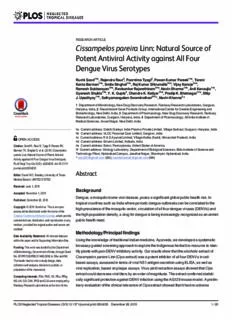
Natural Source of Potent Antiviral Activity against All Four Dengue Virus Serotypes PDF
Preview Natural Source of Potent Antiviral Activity against All Four Dengue Virus Serotypes
RESEARCHARTICLE Cissampelos pareira Linn: Natural Source of Potent Antiviral Activity against All Four Dengue Virus Serotypes RuchiSood1¤a,RajendraRaut2,PoornimaTyagi2,PawanKumarPareek1¤a,Tarani KantaBarman1¤a,SmitaSinghal1¤a,RajKumarShirumalla3¤a,VijayKanoje3¤a, RameshSubbarayan3¤a,RavisankarRajerethinam3¤a,NavinSharma1¤b,AnilKanaujia1¤c, GyaneshShukla1¤a,Y.K.Gupta4,ChandraK.Katiyar1¤d,PradipK.Bhatnagar1¤e,Dilip J.Upadhyay1¤a,SathyamangalamSwaminathan2¤f*,NavinKhanna2* 1 DepartmentofMicrobiology,NewDrugDiscoveryResearch,RanbaxyResearchLaboratories,Gurgaon, Haryana,India,2 RecombinantGeneProductsGroup,InternationalCentreforGeneticEngineeringand Biotechnology,NewDelhi,India,3 DepartmentofPharmacology,NewDrugDiscoveryResearch,Ranbaxy ResearchLaboratories,Gurgaon,Haryana,India,4 DepartmentofPharmacology,AllIndiaInstituteof MedicalSciences,AnsariNagar,NewDelhi,India ¤a Currentaddress:DaiichiSankyoIndiaPharmaPrivateLimited,VillageSarhaul,Gurgaon,Haryana,India ¤b Currentaddress:VLCCPersonalCareLimited,Gurgaon,India OPENACCESS ¤c Currentaddress:R&DAyurvetLimited,VillageKatha,Baddi,HimanchalPradesh,India ¤d Currentaddress:EmamiLimited,Kolkata,India Citation:SoodR,RautR,TyagiP,PareekPK, ¤e Currentaddress:Exton,Pennsylvania,UnitedStatesofAmerica BarmanTK,SinghalS,etal.(2015)Cissampelos ¤f Currentaddress:VirologyLaboratory,DepartmentofBiologicalSciences,BirlaInstituteofScienceand pareiraLinn:NaturalSourceofPotentAntiviral Technology-Pilani,HyderabadCampus,JawaharNagar,Shamirpet,Hyderabad,India *[email protected](SS);[email protected](NK) ActivityagainstAllFourDengueVirusSerotypes. PLoSNeglTropDis9(12):e0004255.doi:10.1371/ journal.pntd.0004255 Abstract Editor:DavidW.C.Beasley,UniversityofTexas MedicalBranch,UNITEDSTATES Received:June1,2015 Background Accepted:November1,2015 Dengue,amosquito-borneviraldisease,posesasignificantglobalpublichealthrisk.In Published:December28,2015 tropicalcountriessuchasIndiawhereperiodicdengueoutbreakscanbecorrelatedtothe Copyright:©2015Soodetal.Thisisanopen highprevalenceofthemosquitovector,circulationofallfourdengueviruses(DENVs)and accessarticledistributedunderthetermsofthe thehighpopulationdensity,adrugfordengueisbeingincreasinglyrecognizedasanunmet CreativeCommonsAttributionLicense,whichpermits unrestricteduse,distribution,andreproductioninany publichealthneed. medium,providedtheoriginalauthorandsourceare credited. Methodology/Principalfindings DataAvailabilityStatement:Allrelevantdataare withinthepaperanditsSupportingInformationfiles. UsingtheknowledgeoftraditionalIndianmedicine,Ayurveda,wedevelopedasystematic bioassay-guidedscreeningapproachtoexploretheindigenousherbalbio-resourcetoiden- Funding:ThisworkwasfundedbytheDepartment ofBiotechnology,GovernmentofIndia,throughGrant tifyplantswithpan-DENVinhibitoryactivity.Ourresultsshowthatthealcoholicextractof No.BT/PR7356/PBD/17/465/2006toSSwandNK. CissampelosparieraLinn(Cipaextract)wasapotentinhibitorofallfourDENVsincell- Thefunderhadnoroleinstudydesign,data basedassays,assessedintermsofviralNS1antigensecretionusingELISA,aswellas collectionandanalysis,decisiontopublish,or viralreplication,basedonplaqueassays.VirusyieldreductionassaysshowedthatCipa preparationofthemanuscript. extractcoulddecreaseviraltitersbyanorderofmagnitude.Theextractconferredstatisti- CompetingInterests:RSo,RKS,VK,RSu,RRaj, callysignificantprotectionagainstDENVinfectionusingtheAG129mousemodel.Aprelim- NS,AK,GS,CKK,PKBandDJUwereemployedby RanbaxyResearchLaboratoriesatthetimeofthis inaryevaluationoftheclinicalrelevanceofCipaextractshowedthatithadnoadverse PLOSNeglectedTropicalDiseases|DOI:10.1371/journal.pntd.0004255 December28,2015 1/20 HerbalExtractwithPan-DengueInhibitoryActivity work.Allotherauthorshavedeclaredthatno effectsonplateletcountsandRBCviability.InadditiontoinherentantipyreticactivityinWis- competinginterestsexist.Thisdoesnotalterour tarrats,itpossessedtheabilitytodown-regulatetheproductionofTNF-α,acytokineimpli- adherencetoallPLOSpoliciesonsharingdataand catedinseveredenguedisease.Importantly,itshowednoevidenceoftoxicityinWistar materials. rats,whenadministeredatdosesashighas2g/Kgbodyweightforupto1week. Conclusions/Significance Ourfindingsabove,takeninthecontextofthehumansafetyofCipa,basedonitsusein Indiantraditionalmedicine,warrantfurtherworktoexploreCipaasasourceforthedevelop- mentofaninexpensiveherbalformulationfordenguetherapy.Thismaybeofpracticalrele- vancetoadengue-endemicresource-poorcountrysuchasIndia. AuthorSummary Indiarepresents~50%oftheglobalpopulationestimatedtobeatriskofdengue.Severe dengue,whichispotentiallyfatal,correlateswithveryhighvirusload,reductioninplatelet countsandhaemorrhage.Antiviraltherapytoreducehighvirusloadmaybebeneficialin attenuatingdiseaseseverity.WehaveexploredIndiantraditionalmedicine,Ayurveda,to identifyplantsthatcouldbeasourceofdengueinhibitoryactivity.Weshowthatanalco- holicextractpreparedfromCissampelospareiraLinninhibitedthereplicationofdengue virusesinlivingcellsincultureandprotectedmiceagainstdengueinfection.Italso showedantipyreticandanti-inflammatoryeffects.Importantly,thisextractdidnotshow anytoxiceffectsinratsanddidnotaffectplateletsandredbloodcells.Thisobservationis criticalasdenguefeveriscommonlytreatedwithantipyretics.Inadengue-endemic resource-poorcountryasIndia,theC.pareiraplantmayserveasasourceforthedevelop- mentofaninexpensiveherbalformulationagainstdengue. Introduction Denguediseaseisamajorpublichealthconcernaroundtheworld.Itisspreadtohumans throughthebiteofAedesmosquitoeswhichserveascarriersofthedisease-causingviruses. Therearefourserotypesofdengueviruses(DENV-1,-2,-3and-4),belongingtothefamily Flaviviridae[1],whichareprevalentinmorethanahundredmosquito-infestedcountriesin thetropicalandsub-tropicalregionsoftheglobe[2,3].Accordingtorecentestimates,there areannually~400millioninfectionsaroundtheworldandafourthoftheseareassociatedwith symptomaticdengueillness[3].Symptomaticdengueillnesscanrangefrommilddenguefever (DF)tosevereandpotentiallyfataldenguehaemorrhagicfever(DHF)anddengueshocksyn- drome(DSS)[4].InDF,theappearanceofvirusintheserumcoincideswithfeveronset,with titersreaching106infectiousunits/ml,atthepeakofthefebrilephase.InDHF/DSSpatients, theviremiacanescalateby1–2logs[5,6].Thisisaccompaniedbypotentiallyfatalmanifesta- tionsofthrombocytopenia,haemorrhage,vascularleakageandshock[1,2,7].Unlesshospital- izedandgivensupportivecareandfluidreplacement,DHF/DSScanbeassociatedwithhigh casefatalityrates[4].Controllingthespreadofdenguecontinuestobeanintractableproblem duetotheinabilitytoeradicatethevectormosquitoesandthelackofsafe,potentpreventive vaccine[8,9].Despitenumeroushurdles,persistenteffortsovertheyearshaveresultedinthe developmentofseveralliveattenuateddenguevaccinecandidates[9],oneofwhichhas PLOSNeglectedTropicalDiseases|DOI:10.1371/journal.pntd.0004255 December28,2015 2/20 HerbalExtractwithPan-DengueInhibitoryActivity undergonephaseIIIclinicaltesting[10–12]andisexpectedtobelicensedinthenearfuture. Thechallengesbeingfacedindenguevaccinedevelopment[13]haveemphasizedtheneedfor antiviraldrugsandspurredneweffortsinthisdirection[14–16]. Inregardtodrugs,amajorityusedintreatinghumanillness[17]andseveralinclinical development[18]canbetracedtonaturalorigins.Indiahasarichherbalrepertoirewhichis usedintraditionalethnomedicine.Thecurrentworkwasundertakenwiththeobjectiveof exploringthepossibilityofidentifyinganti-DENVactivitythatmaybeassociatedwithindige- nousplantsinIndia.Tochooseplantslikelytoprovideusefulleads,thestudyutilizedknowl- edgefromtraditionalIndianmedicine,Ayurveda,aspecificbranchofIndianethnomedicine [19].Ayurvedaprescribesmedicinesbasedonvariousherbsforavarietyofillnesses.Though dengueassuchisnotdescribedinAyurvedicliterature,thereareillnessesidentifiedbysymp- tomsthatcanbecorrelatedwithsomeoftheclinicalmanifestationsofdenguedisease.Plants shortlistedonthisbasisfromthevastindigenousherbalbio-resourceavailableinIndiawere screenedforanti-DENVactivity.Thisworkdescribesthescreeningassaysthatwereset-upto identifyanti-DENVactivityandpresentsdataidentifyingtwoplantsthatmanifestedinhibitory potencyagainstall4DENVs.Oneofthese,chosenforfurtherstudytoassessitsinvivoefficacy andclinicalrelevance,wasfoundtobeapromisingcandidateforfurtherdevelopmentasa pan-DENVinhibitoryformulation. Methods Cellsandviruses ThemosquitocelllineC6/36,themonkeykidneycelllinesLLCMK andVero,andhuman 2 hepatomacelllineHepG2werefromAmericanTypeCultureCollection,Virginia,U.S.A.C6/ 36cellsweremaintainedinLeibovitzL-15mediumsupplementedwith0.03%tryptosephos- phatebrothand10%heat-inactivatedfetalcalfserum(ΔFCS)inaCO -freeincubatorat28°C. 2 ThemonkeykidneycellsweremaintainedinDulbecco’sModifiedEaglemedium(DMEM), supplementedwith10%ΔFCS,ina5%CO humidifiedincubator,at37°C.ForHepG2cells, 2 DMEMwasreplacedbyRoswellParkMemorialInstitute(RPMI)medium.Theremaining conditionswerethesame.RepresentativesofthefourDENVserotypes(strainandaccession numbersareindicatedinparentheses)usedinthisstudywere:DENV-1(NauruIsland, U88535);DENV-2(NewGuineaC,AF038403),DENV-3(H87,M93130)andDENV-4(Dom- inica,M14931).ThesewerepropagatedinC6/36cellsandtitratedonLLCMK cellsusinga 2 standardplaqueassayasdescribedbelow. Plantsandpreparationofextracts PlantsshortlistedforscreeningareindicatedinTable1.Thesewereprocuredthroughlocalsup- pliersandidentifiedandauthenticatedbytheresidentherbaltaxonomistatRanbaxyResearch Laboratories,Gurgaon,India.Extractswerepreparedusingpart(s)oftheplantsusedinconven- tionalAyurvedicpreparations.Ineachcase,threedifferentextracts,methanolic,hydroalcoholic andaqueous,werepreparedusingmethanol,methanol:water(1:1),andwater,respectively.Plant partswerewashed,shade-driedandpulverizedpriortoextraction.Toprepareextracts,~100g plantmaterialwasextractedthreetimeswith500mlextractionsolventatboilingpointfor3 hours,eachtime.Thethreeextractionswerepooled,filteredandconcentratedatlowpressure andtemperature,anddriedinavacuumovenatroomtemperature(RT)for16–18hours.The resultantmaterialwasdissolvedindimethylsulfoxide(DMSO),at20mg/mlandstoredat4°C. PLOSNeglectedTropicalDiseases|DOI:10.1371/journal.pntd.0004255 December28,2015 3/20 HerbalExtractwithPan-DengueInhibitoryActivity Table1. Screeningofplantextractsforanti-DENVactivity. No. NameofPlant Partuseda AntiviralActivityb 1 Aconitumheterophyllum Rhizome - 2 Andrographispaniculata Wholeplant - 3 Azadirachtaindica Bark - 4 Cedrusdeodara Resin - 5 Cissampelospareira Aerialpart + 6 Coptisteeta Root + 7 Cyperusrotundus Rhizome - 8 Desmodiumgangeticum Wholeplant + 9 Enicostemmalittorale Wholeplant - 10 Fumariaindica Wholeplant + 11 Ocimumsanctum Wholeplant - 12 Phyllanthusamarus Wholeplant + 13 Picrorhizakurroa Rhizome ± 14 Premnamucronata Bark + 15 Swertiachirayata Wholeplant - 16 Terminaliachebula Fruit + 17 Tinosporacordifolia Stem + 18 Aloevera Leaf - 19 Citrulluscolocynthis Root - aMethanolicextractswerepreparedusingpartsoftheplantmentionedinAyurvedicliterature bAntiviralactivityagainstDENV-3screenedusingType-1assay.“+”indicatesactiveextract(IC <25μg/ml); 50 “±”indicatesborderlineextracts(IC =~25μg/ml);“-”indicatesinactiveextract(IC >25μg/ml) 50 50 doi:10.1371/journal.pntd.0004255.t001 Plaqueassay ThetiterofinfectiousDENVinvirusstocksandinculturesupernatants(inthetype-3screen- ingassay,seebelow)weredeterminedusingastandardplaqueassayasdescribedpreviously [20].Briefly,LLCMK monolayersin6wellplateswereinfectedinduplicatewithserial10-fold 2 dilutions(preparedinDMEM+2%ΔFCS)ofthevirus-containingsamples(250μl/well).Mock- infectionswereperformedinparallelusinganequivalentvolumeofvirusdiluentalone.Two hourslater,theinfectedmonolayers(afteraspiratingoffthevirusinoculum)wereoverlaid withDMEM+6%ΔFCScontaining1%methylcellulose(2ml/well),andincubatedfor6days (37°C,5%CO ).Onday6post-infection,theoverlaywasremovedandthecellsfixedwith4% 2 formaldehydesolution(1ml/well).Fixedcellswerewashedandstainedwith0.05%(w/v)crys- talvioletsolutionin20%ethanol.Revealedplaqueswerecountedtodeterminethevirustitre, expressedasplaque-formingunits(PFUs)/ml. Cell-basedbioassaysforantiviralscreening Theinitialantiviralscreeningassay,designatedasthetype-1assay,wasbasedontheplaque reductionneutralizationtest(PRNT)describedearlierfordeterminingDENV-neutralizing antibodytitresinsera[20].LLCMK cellswereseededin24-wellplates(5x105cells/well),a 2 dayinadvance.DENV-1,-2,-3and-4(100PFUeach)wereseparatelypre-incubatedwith serialdilutionsofherbalextracts(correspondingto0–100μg/mlfinalconcentration)in300μl volume,at4°Covernight.Thepre-incubationmixturewasdilutedwithanequalvolumeof medium(DMEM+2%ΔFCS)andusedtoinfectLLCMK cells(3wellsforeachconcentration 2 at200μl/well)inthe24-wellplate.After2hoursofadsorptionintheincubator(37°C,5% PLOSNeglectedTropicalDiseases|DOI:10.1371/journal.pntd.0004255 December28,2015 4/20 HerbalExtractwithPan-DengueInhibitoryActivity CO ),infectedcellswereoverlaidwithmethylcellulose-containinggrowthmediumandpro- 2 cessedthereafterasdescribedfortheplaqueassayabove.Toassessanypotentialcytotoxicity, cellswereexposedtotheherbalextracts(inthesameconcentrationrange)intheabsenceof DENVinfection.Additionalcontrolexperiments,runinparallel,includedcellswhichwere eithermock-infected(negativecontrol)orinfectedwithDENVintheabsenceofherbalextract (positivecontrol).Thehalf-maximalinhibitoryconcentration(IC value)foreachherbal 50 extractagainsteachDENVserotype,withreferencetothepositivecontrolwhichrepresented 100%infection(or0%inhibition),wasdefinedastheconcentrationofherbalextract,inμg/ml, resultingin50%inhibitionoftheplaquecount. Inthetype-2screeningassay,LLCMK cellsin24-wellplateswereinfectedwithDENVs 2 (moi=0.002)withoutpre-incubatingwiththeherbalextracts.After2hoursofadsorption,the virusinoculumwasaspirated,themonolayerrinsed,andthenfedwithcompletemediumcon- tainingtheherbalextracts(correspondingto0–200μg/mlfinalconcentration).After24hours ofexposuretotheextract,themonolayerwasaspiratedandoverlaidwithgrowthmediumcon- tainingmethylcelluloseandplaquesdeveloped6dayslaterasabove. Thetype-3assaywasdoneusingVerocells,asthesecellssecretetheviralantigenNS1and theinfectiousvirionsefficientlyintotheculturemediumuponDENVinfection.Theassay designwassimilartothetype-2assay,exceptthatfollowingsequentialexposureofcellsto DENVandherbalextract,cellswerefedwithliquidgrowthmedium,insteadofthemethylcel- luloseoverlay.Aliquotsoftheculturesupernatantwerewithdrawnatperiodicintervalsupto9 daysforestimationofNS1antigenlevels(usingacommercialELISAkit)andvirustitres(by plaqueassay,asdescribedabove). DeterminationofcytotoxicityofCipaextract Cytotoxicitywasevaluatedintwocelllines,LLCMK (inwhichtheantiviralactivityofthe 2 extractswereassayed)andHepG2,acommonlyusedlivercellsurrogateforinvitrocytotoxic- itytesting.Cellsseededin96-wellplateswereexposedtoawideconcentrationrangeofCipa extract(1–200μg/ml)for3days.CellviabilitywasassessedusingacommercialMTT(3- [4,5-dimethylthiazol-2-yl]-2,5-diphenyltetrazoliumbromide)assaykit(Sigma,cat.#M5655) withreferencetocontrolcellsthatwerenotexposedtotheextract.Thehalf-maximalcytotoxic concentration(CC value)fortheherbalextract,withreferencetothepositivecontrol 50 (untreatedcells)whichrepresented100%cellviability(or0%cytotoxicity),wasdefinedasthe concentrationofherbalextract,inμg/ml,resultingin50%cytotoxicity.Selectivityindex(SI)of anextractisdefinedastheratioofCC toIC valuesobtainedusingtheLLCMK cellline. 50 50 2 Effectofpre-incubationtimeandvirusdoseontheanti-DENVactivityof Cipaextract Toassessifthedurationofpre-incubationoftheCipaextractwithDENVinfluencedantiviral activityinthetype-1assayformat,pre-incubationtimesrangingfrom0–24hoursweretested using~50PFUsofDENV-3. ToassesstheeffectofthesizeoftheDENVdoseontheanti-DENVefficacyofCipaextract inthepre-incubationstep(at4°C,overnight),type-1assayswereperformedusingDENV-3 rangingfrom50to5000PFUs.EachdoseofDENV-3wasassayedagainstCipaextractranging inconcentrationfrom0–200μg/ml. EvaluationofinvivoefficacyofCipaextractintheAG129mousemodel ToprepareastockofchallengeviruscapableoflethalinfectioninAG129,weusedapreviously publishedstrategy[21,22]withsomemodifications.EssentiallyDENV-2(NGC)was PLOSNeglectedTropicalDiseases|DOI:10.1371/journal.pntd.0004255 December28,2015 5/20 HerbalExtractwithPan-DengueInhibitoryActivity alternatelypassagedbetweenAG129(intracranialinoculationof106PFU)andC6/36cellsin tissueculture.After4–5suchcyclesofpassaging,theviruswastestedinAG129micetodeter- minetheminimumlethaldose(MLD)byi.p.injections.MLDisdefinedasthedosethatcan causeclinicalsymptomsand90–100%death3–4weekspostchallenge.Thechallengevirus stockthusobtainedwastitrated,aliquottedandstoredinliquidN untiluse.Totestprotective 2 efficacyofCipaextract,AG129mice(9–12weeksold,20–24gbodyweight)werechallenged with106PFU(permouse,0.4ml,i.p)ofthechallengeDENV-2stockdescribedabove.Chal- lengedmiceweredividedintogroups(n=6)andtreatedorallywithvehiclealone(0.25% methylcellulose)orwithtwodifferentdosesofCipaextract(at125mgand250mg/kgbody weight).ThemethanolintheCipaextractsadministeredtomicewasremovedcompletelyby evaporation.Theresultantmethanol-freeCipapastewasthoroughlyre-suspendedin0.25% methylcellulosewaterandadministeredorallytoinfectedmice.Thevolumeoftheoraldose wasadjustedinaccordancewiththebodyweightofeachanimal(10ml/Kg/dose)andadminis- teredbyatrainedveterinarianusingaspeciallydesignedmousefeederneedlefittedwitha graduated1mldisposablesyringe.Thetreatmentwasinitiated2hourspost-infectionandcon- tinuedtwicedailyfor5consecutivedays.Animalsweremonitoredtwicedailyforaperiodof 35daysforclinicalsymptomsandmortality.Acontrol(sham)groupthatwasnotvirus-chal- lenged,butwhichreceivedCipaextract(250mg/kg),wasalsotestedinparallel.Attheendof theexperiment,thesurvivaldatawasusedtoplotKaplanMeiersurvivalcurvesandanalysed bythelogranktest(Mantel-Cox)testforstatisticalsignificanceusingGraphPadPrism5 software. DeterminationofeffectofparacetamolonCipaextractinvitroandinvivo InteractionbetweenparacetamolandCipaextractwasassessedinvitrousingtype-1assay formatasfollows.DENV-3(~50PFUs)andCipaextract(ranginginconcentrationfrom 0–50μg/ml)werepre-incubatedovernightat4°Cinavolumeof100μl,andusedtoinfect LLCMK cellsin24-wellplates.Parallelinfectionsweresetupusingpre-incubationmixtures 2 containingparacetamol(1–100μg/ml),inadditiontoDENVandCipaextract.Asbefore, mock-infectionsandDENVonlyinfections(intheabsenceofCipaandparacetamol)werealso setupandanalysedinparallel. TheinvivoeffectofCipaextractinthepresenceandabsenceofparacetamolwasassessed usingtheWistarratpyrexiamodel.Wistarrats(weighing180–220g)ofeithersexwereused. Basaltemperatureoftheratswasmeasuredusingadigitalrectalthermometer(Experimetria Ltd.,Hungary)andtheninjectedsubcutaneously(intheintra-scapularregion)with20%brew- er’syeast(10ml/kgbodyweight)andallowedtofastovernightwithfreeaccesstowater.At18 hourspost-injection,rectaltemperatureswererecordedagaintoidentifyanimalsthatregis- tered(cid:1)0.7°Criseinbodytemperatureforinclusioninthestudy.Groups(n=7–9)offebrile ratswereorallyadministeredparacetamol(200mg/kg),orCipaextract(200mg/kg)orboth. Ratsinthecontrolgroupreceivedjustthevehicle(0.5%methylcellulose).Thiswasfollowed byrecordingofrectaltemperaturefor3hoursat30minuteintervals. EffectofCipaextractonerythrocytesandplateletsexvivoandinvivo Forexvivostudies,humanbloodwascollectedfromhealthyadultdonorsafterinformedcon- sent.Erythrocyteswerepelleteddowninacentrifuge(1500xg,5minutes)fromfreshlycol- lectedheparinizedblood,rinsedthoroughlywithPBS(pH7.4),andusedtomakea1%cell suspensioninPBS.Cipaextractranginginconcentrationfrom12.5to400mg/Lwasaddedto theerythrocytesuspensionandincubatedat37°Cfor1hour.Afterthis,thesampleswerespun down,andtheabsorbanceofthesupernatantmeasuredat576nmtodeterminetheextentof PLOSNeglectedTropicalDiseases|DOI:10.1371/journal.pntd.0004255 December28,2015 6/20 HerbalExtractwithPan-DengueInhibitoryActivity erythrocytelysis.Controlswhereinerythrocyteswereincubatedwithbufferalone(0%lysis), DMSOalone(Cipasolvent)and0.1%TritonX-100(100%lysis)wereprocessedinparallel. Basalplateletcountinfreshlycollectedheparinizedbloodandinbloodpre-incubatedwith DMSO(vehicle)orCipaextract(2–10μg/ml)fordifferentdurations(1–4hours)wasdeter- minedusingaBeckmanCoulterhematologyanalyser. Forinvivostudies,fourgroups(n=5)ofWistarratswerefastedovernightandadminis- teredorallywithvehicle(0.25%methylcellulose)orCipaextract,atthreedifferentdosages (100,300and1000mg/kgbodyweight).BloodwascollectedjustbeforeCipaextractadminis- tration(0hour)andat1and4hourspost-administration.Hematologyparametersweremea- suredusingADVIA-120hematologyanalyser. Cytokinereleaseassay Humanperipheralbloodmononuclearcells(PBMCs)wereobtainedasfollows.Freshlycol- lectedheparinizedbloodwasdilutedwithanequalamountofRPMI1640mediumandlay- eredonFicollHypaque1077andcentrifugedat2,500rpmfor25minutesatRT.Theupper layerwasdiscardedandthefluffylayerattheinterphasewasharvested,rinsedandre-sus- pendedinRPMI1640at5x105cells/ml.FreshlycollectedPBMCswereseededin96-well plates(105cells/well)andtreatedwithCipaextractatdifferentdilutions(inRPMI1640),fol- lowedby30minutesincubationatRTonarotaryshaker(200rpm).Next,wellsweretreated with50μl(4μg/ml)lipopolysaccharide(SigmaCat.#L2654)andallowedtoincubatefora further30minutesatRT.Thevolumeperwellwasmadeupto200μlusingRPMI+10%FCS andtheplatesincubatedovernightat37°CinaCO incubator.Negativecontrols(nolipo- 2 polysaccharidetreatment)wereruninparallel.Theplateswerecentrifuged(3000rpm, 10minutes)toobtainclarifiedsupernatantsforTNF-α(e-Bioscience,cat#BMS223/4TEN,) andIL-1β(BDBioscience,cat#557953)determinationsusingcommercialELISAkitsasper thevendors’instructions. Toxicology Groupsof5adultWistarratswereorallyadministered4ml0.25%methylcellulose(vehicle)/kg or4mlvehiclecontaining400mgto2000mgCipaextract/kg,oncedailyfor7days(inaccor- dancewithOECDguidelines-407).Duringthisperiod,foodintake,bodyweight,andclinical signsweremonitoreddaily.Attheendoftheexperiment,animalswereeuthanized,followedby determinationofhematological(Hb,WBCcount,RBCcount,plateletcountandhematocrit) andbiochemical(SGOT,SGPT,totalprotein,serumalbumin,totalcholesterol,urea,creatinine andrandomsugar)parameters.Necropsywasperformed.Organweightswererecordedandhis- topathologywasdone. Ethicalclearance Humanbloodfromhealthyvolunteerswascollectedafterwritteninformedconsentinstrict accordancewithapprovedguidelinesoftheHumanEthicsCommittee,RanbaxyLaboratories, whichapprovedthe‘Clinicalprotocolforcollectionofbloodsamplesfromhealthyadult humansubjectsforscreeningofpotentialnewchemicalentitiestoinhibitcytokinereleaseand otherinvitroparametersinanassaysystem’throughEthicalApprovalnumber:5001_cok_11. Allanimalexperimentswereperformedinstrictaccordancewithguidelinesspecifiedbythe CommitteeforthePurposeofControlandSupervisionofExperimentsonAnimals(CPCSEA) oftheGovernmentofIndia.AnimalexperimentalprotocolswereapprovedbytheInstitutional AnimalEthicsCommittee(IAEC)ofRanbaxyResearchLaboratories,IndiathroughApproval number151/07. PLOSNeglectedTropicalDiseases|DOI:10.1371/journal.pntd.0004255 December28,2015 7/20 HerbalExtractwithPan-DengueInhibitoryActivity Results Designofscreeningassays ThreebioassaysweredevelopedtoidentifyherbalextractswithpotentialDENV-inhibitory activity,asshownschematicallyinFig1.Thetype-1assaywasdesignedtoidentifyherbal extractsthathadtheabilitytoblockDENVfromenteringsusceptiblecells.Asastandardized referenceisnotavailabletoassesstheefficacyofDENVinhibitorypotency,PRNTdataof monoclonalantibodies(mAbs)wereusedtodecideonthecut-offvalueinthetype-1assay.For example,twopan-DENVmAbs,4G2andDB13-19,showhalfmaximalinhibitionofDENV-2 plaquecountsat11and33μg/ml,respectively[23].Basedonthisobservation,anextract whichshowedanIC value(cid:3)25μg/ml,avaluewhichfallsbetweenthesetwo,wasdesignated 50 tobeactiveasaDENVinhibitor.Consideringthatthisvalueisforacrudemulticomponent extract,itrepresentsastringentcut-off.Inthecontextofantiviralscreening,thisassayhadthe followingpossibleoutcomes:theextractcouldbecytotoxic(compromisedmonolayer),inactive (noreductioninplaquesincomparisontocontrolinfection),oractive(reducednumberofpla- ques).However,thetype-1assayisnotlikelytonecessarilyrevealiftheactiveextractsalsopos- sessedtheabilitytoinhibitpost-entrystepsintheDENVlifecycle. Thetype-2assaywasdesignedtoassessthecapacityoftheherbalextractstoinhibitDENVs withinthecell.Therefore,DENVinfectionprecededexposuretotheherbalextract.Asthe herbalextractmustbeinternalizedbeforeitexertsanyinhibitoryeffect,wedecidedtouse higheramountsoftheextract.Accordingly,thecut-offinthetype-2assaywasincreasedto 150μg/ml.Possibleoutcomesinthetype-2assayareasfollows:onceagain,theextractcouldbe Fig1.Schematicrepresentationoftheantiviralscreeningassays.Anoutlineofthethreetypesofscreeningassays(indicatedbyArabicnumbers1,2 and3)isshown.Themulti-colouredsphererepresentsDENVandtheEppendorftubewithgreenliquidrepresentstheherbalextract.Thesetwowerepre- incubated(1)beforeadditiontothemonolayeroraddedsequentially(2,3)tothemonolayer.Inassays1and2,thetreated-monolayerswereoverlaidwith methylcellulose-containinggrowthmedium.Shownatthebottomarethepossibleoutcomesofthetype1and2assays.The‘x’markdenotesfailureofentry intocells.Inassay3,liquidgrowthmediumwasaddedinsteadofthemethylcelluloseoverlay,andfollowedbyanalysisofNS1andvirusreleasedintothe culturesupernatant. doi:10.1371/journal.pntd.0004255.g001 PLOSNeglectedTropicalDiseases|DOI:10.1371/journal.pntd.0004255 December28,2015 8/20 HerbalExtractwithPan-DengueInhibitoryActivity cytotoxic.Ifnot,itmaybeineffectiveduetooneoftworeasons:theextractfailedtoenterthe cells,oritwasineffectivedespitesuccessfulentry.Thefinalpossibilityisthattheextractwould reducetheplaquecount,indicatingantiviralactivity.Thetype-3assaywasdesignedtomonitor inhibitionbasedonreductioninviralantigenproductionandvirusyieldsfromDENV-infected cellsfollowingtreatmentwithherbalextracts.TheamountsofviralNS1antigenandinfectious virusreleasedintotheculturesupernatantweremeasuredovertimetogaugethemagnitudeof inhibition. Inordertoidentifyaneffectiveherbalextractagainstdengue,itwasreasonedthatitmust targetallfourDENVs.Further,itwouldbedesirabletobeabletoinhibitthevirusesboth beforeaswellasafterentryintosusceptiblecells.Towardsthisend,allextractswerescreened againstasingleDENVserotypeinthetype-1assay,followedbyscreeningoftheactiveextracts againsttheremainingthreeserotypes.Next,extractsmanifestingpan-DENVinhibitorypoten- tialinthetype-1assaywereprogressedtoscreeninginthetype-2assay.Extractsidentifiedas activeagainstall4DENVsinthetype-1and-2assaysweretestedintype-3assaytoassesstheir abilitytoreducevirustitresby(cid:1)ten-fold. Identificationofplantextractswithpan-DENVinhibitoryactivity NineteenplantsdescribedinAyurvedicliteratureasbeingbeneficialinthetreatmentofill- nesseswithdengue-likesymptomswereshortlistedforbioassayguidedscreening(Table1). Initialscreeningshowedthatonlythemethanolicextractsmanifestedantiviralactivitywhen assayedagainstDENV-2orDENV-3.Thehydroalcoholicandaqueousextractsofall19plants selectedforthestudydidnotmanifestanyantiviralactivitywhentestedagainstthesetwo DENVserotypes(IC >>100μg/ml).Asaresult,allsubsequentstudieswerecarriedoutusing 50 themethanolicextracts. MethanolicextractswerepreparedfromeachoftheseandscreenedagainstDENV-3ina type-1assay.ExtractsthatmanifestedIC valuesbelowthepre-designatedcut-offwerescored 50 aspositiveandtheremainingasnegativeforantiviralpotency.Theresultsaresummarizedin Table1.Thisscreeningassayrevealed8of19extractstopossessdefiniteanti-DENV-3inhibi- toryactivity,whileonemanifestedborderlineinhibition.These9extractswerethenscreened againsttheremainingthreeDENVserotypesaswellinthetype-1assay.Theseresults,shown inTable2,revealedthat4ofthe9anti-DENV-3extractsmanifestedpotentinhibitoryactivity Table2. ExtractswithPan-DENVinhibitoryactivity. No. Extract Antiviralactivity(IC ,μg/ml) 50 DENV-1a DENV-2a DENV-3a DENV-4a DENV-3b 1 Cissampelospareira 11.11 1.97 3.17 1.23 78 2 Coptisteeta 11.11 5.04 7.87 33.33 >200 3 Desmodiumgangeticum 12.5 6.7 14.62 12.5 >200 4 Fumariaindica 12.5 7.02 11.32 12.5 >200 5 Phyllanthusamarus 3.7 8.33 20.76 11.11 145 6 Picrorhizakurroa 12.5 16.02 27.14 25 >200 7 Premnamucronata 12.5 27.9 21.37 12.5 >200 8 Terminaliachebula 25 70 11.2 50 >100 9 Tinosporacordifolia 50 58.75 16.02 25 >100 aType-1assay(carriedoutusingallDENVserotypes) bType-2assay(carriedoutusingDENV-3alone) doi:10.1371/journal.pntd.0004255.t002 PLOSNeglectedTropicalDiseases|DOI:10.1371/journal.pntd.0004255 December28,2015 9/20 HerbalExtractwithPan-DengueInhibitoryActivity Table3. Extractsdisplayingpan-DENVinhibitoryactivityinType-2assay. No. Extract Antiviralactivity(IC ,μg/ml) 50 DENV-1 DENV-2 DENV-3 DENV-4 1 Cissampelospareira 100 125 78 100 2 Phyllanthusamarus 100 133 145 100 doi:10.1371/journal.pntd.0004255.t003 againsttheremainingthreeDENVserotypesaswell.Therestwereeffectiveatleastagainsttwo otherDENVserotypes.Whenallthese9weretestedinatype-2assayagainstDENV-3toiden- tifyextractsthatmayinhibitthevirusafteritsentryintocells,twoextracts,oneobtainedfrom CissampelospareiraLinn,andtheotherfromPhyllanthusamarus,wereeffectiveincurbing DENV-3(IC values<150μg/ml).Extendingthetype-2assaytoDENV-1,-2and-4revealed 50 thatboththeseextractspossessedtheabilitytoinhibitallfourDENVsevenaftertheirentry intocells(Table3).WhilePhyllanthusamarushasbeendocumentedtopossessantiviralprop- ertiesagainstanotherflavivirus,HepatitisCvirus[24]aswellasmanyotherviruses[25],this isthefirstreportofantiviralactivityassociatedwithCissampelospareiraLinn.Furtherstudies inthisworkfocusedonCissampelospareiraLinn,henceforthdesignatedasCipafor convenience. Cipaextractsfromdifferentgeographicallocationsaresimilarin compositionandantiviralpotency Fromtheperspectiveofevaluatingtheavailabilityofstartingmaterial,itwasconsideredneces- sarytoascertaintheextentofseasonalandgeographicalvariationsinthecapacityoftheCipa extracttomanifestDENVinhibitoryactivity.Tothisend,extractswerepreparedfromCipa plantscollectedduringdifferentseasonsfrommultiplegeographicallocationswithinIndia. Analysisoftheseextractsrevealedthattheanti-DENVinhibitoryactivityisevidentinplants collectedduringthefloweringseasonofApriltoSeptember[26].Intheexperiment,theresults ofwhicharesummarizedinTable4,Cipaextractswerepreparedfromplantsobtainedduring thefloweringseasonfromfourdifferentlocations,andevaluatedusingthetype-1assay describedabove.ThedatashowthatCipaextractsmanifestedpan-DENVinhibitoryactivityin bothassayformats.Further,theobservedmeanpan-DENVIC valueswerenotsignificantly 50 differentforallfourgeographiclocationstested.Fractionationofthemethanolicextractswith differentsolventsresultedinnominalincreaseinantiviralefficacyandasignificantlossin Table4. Profileofanti-DENVactivityofextractsfromCipacollectedfromgeographicallydiverselocations. Extract/Fraction S.India N.India Rajasthan M.P. IC a(μg/ml) Yieldb(%) IC a(μg/ml) Yieldb(%) IC a(μg/ml) Yieldb(%) IC a(μg/ml) Yieldb(%) 50 50 50 50 Methanolic 7.12 6 8.01 5.96 7.46 8.62 21.38 13.2 Hexane 2.33 1.37 2.10 1.25 2.89 1.5 2.79 2.15 Chloroform 1.02 0.53 1.05 0.66 1.08 0.25 3.62 0.26 Dichloromethane 2.94 0.61 1.61 0.69 1.72 0.22 6.42 0.3 Ethylacetate 2.89 2.57 4.07 2.74 2.7 2.93 4.65 3.44 Acetone 1.68 2.11 3.05 2.02 1.88 2.3 2.93 2.78 aDenotespan-DENVinhibitoryactivity(meanoftheIC valuestargetingeachofthefourDENV-serotypes) 50 b%Yield=(wt.ofextractorfractionobtained/wt.ofstartingmaterial)x100 doi:10.1371/journal.pntd.0004255.t004 PLOSNeglectedTropicalDiseases|DOI:10.1371/journal.pntd.0004255 December28,2015 10/20
Description: